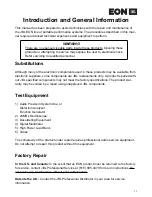
Viewing real-time patient data
2001989-200E
ApexPro™
7-23
The ST value shown in the ECG parameter window is the lead with the greatest ST
deviation. This may or may not be the lead that is in alarm, since a lead with a lesser
deviation from the isoelectric line may have changed more than the lead with the
greatest deviation.
NOTE
ST numerics are always calculated with reference to 1X size. Displaying the
ECG waveform at a different size does
not
affect the ST values.
NOTE
When a new dominant beat is detected or a relearn occurs, the arrhythmia
program calculates ST based on the new beat. This could affect the ST values
displayed. This may not necessarily represent a change in the patient’s condition.
The clinician needs to assess the patient any time there is an ST change.
NOTE
Adjustable ST alarms are only available when using a CIC Pro center running
software version 5 or later. If your CIC Pro center is running an earlier version of
software, this feature is not available. Contact your sales/service representative
for more information.
ST deviation alarm
When any individual ST value is beyond the limit, an ST deviation alarm occurs. It is
considered a parameter alarm, and the default alarm level is
Warning
. This can be
modified in the parameter alarm level setup.
When the ST program is turned on, or a relearn is done with ST on, the ST
deviation values are set for all leads of ST.
The current ST value is determined in all eight leads.
The ST value in the ECG parameter window turns red to indicate an alarm.
ST limits can also be adjusted individually in the patient’s
Alarm Control
tab.
NOTE
ST limits can also be adjusted at the CIC Pro center from
Monitor Setup
>
ECG
.
Adjusting ST limits
ST alarm limits and levels for telemetry patients are typically controlled by the
default ST alarm levels from the CIC Pro center. Some bedside monitors allow users
to adjust ST alarm limits and levels at the bedside when the patient is admitted in
combination monitoring mode. For more information on adjusting ST limits, refer to
the bedside monitor operator’s manual.
Summary of Contents for ApexPro
Page 13: ...2001989 200E ApexPro 1 1 1 Introduction ...
Page 31: ...2001989 200E ApexPro 2 1 2 Equipment overview ...
Page 36: ...2 6 ApexPro 2001989 200E Equipment overview ...
Page 37: ...2001989 200E ApexPro 3 1 3 Equipment setup ...
Page 50: ...3 14 ApexPro 2001989 200E Equipment setup ...
Page 51: ...2001989 200E ApexPro 4 1 4 System setup ...
Page 69: ...2001989 200E ApexPro 5 1 5 Alarms ...
Page 86: ...5 18 ApexPro 2001989 200E Alarms ...
Page 87: ...2001989 200E ApexPro 6 1 6 Managing patients ...
Page 109: ...2001989 200E ApexPro 7 1 7 Viewing real time patient data ...
Page 144: ...7 36 ApexPro 2001989 200E Viewing real time patient data ...
Page 145: ...2001989 200E ApexPro 8 1 8 Viewing stored patient data ...
Page 166: ...8 22 ApexPro 2001989 200E Viewing stored patient data ...
Page 167: ...2001989 200E ApexPro 9 1 9 Printing ...
Page 175: ...2001989 200E ApexPro A 1 A Abbreviations and symbols ...
Page 183: ...2001989 200E ApexPro B 1 B Customized defaults worksheet ...
Page 186: ...B 4 ApexPro 2001989 200E Customized defaults worksheet ...
Page 187: ...2001989 200E ApexPro C 1 C Maintenance ...
Page 194: ...C 8 ApexPro 2001989 200E Maintenance ...
Page 195: ...2001989 200E ApexPro D 1 D Troubleshooting ...
Page 206: ...D 12 ApexPro 2001989 200E Troubleshooting ...
Page 207: ...2001989 200E ApexPro E 1 E Technical specifications ...
Page 214: ...E 8 ApexPro 2001989 200E Technical specifications ...
Page 217: ......
















































